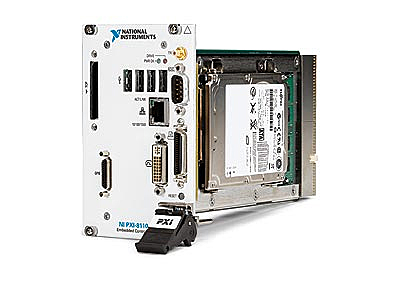National Instruments introduces the NI PXI-8110 embedded controller, which is the industry’s first 3U quad-core embedded controller for PXI systems. Featuring a 2.26 GHz Intel® Core™2 Quad processor Q9100, up to 4 GB 800 MHz DDR2 RAM and a high-performance 7200 rpm drive, it is also the industry’s fastest embedded controller in the 3U PXI class. The PXI-8110 provides an up to 80 percent performance improvement over dual-core controllers with similar CPU clock frequencies for applications that are optimized to use the controller’s four processing cores.

Computer processor manufacturers are continuing to add more CPU cores to their processors as a way of enhancing computing power. When using traditional text-based programming languages, engineers who want to harness this computing power for developing advanced test, measurement and control applications regularly face the challenges of using complex software primitives and programming models. However, engineers and scientists can capitalize on multi-threaded application development by combining the multicore support and parallelism of National Instruments LabVIEW graphical system design software with the PXI-8110 controller’s advanced functionality. Because the new controller features a platform on which an application can distribute processing loads across four CPU cores simultaneously, it can significantly reduce test times for applications that require intensive signal and data processing such as RF protocol testing and hardware-in-the-loop (HIL) simulations. These applications also can replicate specific tests or processes to run on separate CPU cores and effectively double system throughput.
As an example of its leading-edge performance, the PXI-8110 can process up to 215,000 1K fast Fourier transforms (FFTs) per second, which is approximately 80 percent faster than the NI PXI-8108 dual-core embedded controller. Previously, this type of performance could be achieved only by using a bulky workstation. The PXI-8110 offers this same capability in a compact, 3U form factor that fits seamlessly inside a PXI chassis.
The PXI-8110 also is available in a version that supports the NI LabVIEW Real-Time and LabWindows™/CVI Real-Time modules to deliver a flexible and rugged platform for deterministic and real-time measurement and control. With dual-core real-time systems, engineers are limited to a single CPU core to execute time-critical application segments because the other core is used for executing noncritical background services. With the new PXI-8110 quad-core embedded controller, engineers can allocate multiple CPU cores for running time-critical test sections while delegating noncritical services to the remaining cores. This capability helps engineers create powerful real-time and deterministic systems.


Leave a Reply
You must be logged in to post a comment.